Click below to jump to an article of interest.
Hot Times in Cool Places
A team co-led by SwRI found evidence for hydrothermal or metamorphic activity within the icy dwarf planets Eris and Makemake, located in the Kuiper Belt. Methane detected on their surfaces has the tell-tale signs of warm or even hot geochemistry in their rocky cores. This is markedly different than the signature of methane from a comet, which is what the team was expecting to find.
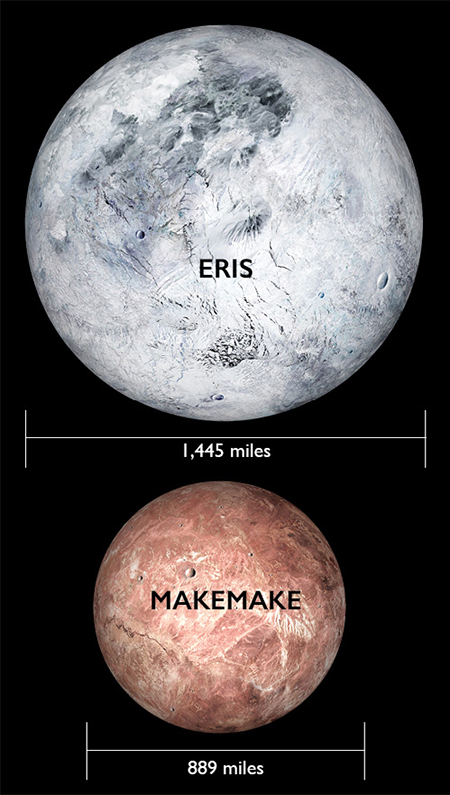
“We see some interesting signs of hot times in cool places,” said SwRI’s Dr. Christopher Glein, an expert in planetary geochemistry and lead author of a paper about this discovery. “I came into this project thinking that large Kuiper Belt objects (KBOs) should have ancient surfaces populated by materials inherited from the primordial solar nebula, as their cold surfaces can preserve volatiles like methane. Instead, the James Webb Space Telescope (JWST) gave us a surprise! We found evidence pointing to thermal processes producing methane from within Eris and Makemake.”
The Kuiper Belt is a vast donut-shaped region of icy bodies beyond the orbit of Neptune at the edge of the solar system. Eris and Makemake are comparable in size to Pluto and its moon Charon. These bodies likely formed early in the history of our solar system, about 4.5 billion years ago. Far from the heat of our Sun, KBOs were believed to be cold, inert objects — until now.
Newly published work from JWST studies made the first observations of isotopic molecules on the surfaces of Eris and Makemake. These so-called isotopologues are molecules that contain atoms having a different number of neutrons, useful in understanding planetary geology.
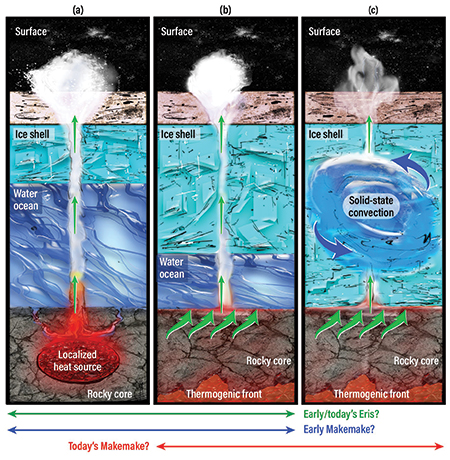
Using data from the James Webb Space Telescope, SwRI modeled the subsurface geothermal processes that could explain how methane ended up on the surfaces of Eris and Makemake, two dwarf planets in the distant Kuiper Belt. The illustration points to three possibilities, including the potential that liquid water exists within these icy bodies at the edge of the solar system, far from the heat of the Sun.
The JWST team measured the composition of the dwarf planets’ surfaces, particularly the deuterium (heavy hydrogen, D) to hydrogen (H) ratio in methane. Deuterium is believed to have formed in the Big Bang, and hydrogen is the most abundant nucleus in the universe.
“The moderate D/H ratio we observed with JWST belies the presence of primordial methane on an ancient surface. Primordial methane would have a much higher D/H ratio,” Glein said. “Instead, the D/H ratio points to geochemical origins for methane produced in the deep interior.
“The D/H ratio is like a window. We can use it in a sense to peer into the subsurface,” Glein added. “Our data suggest elevated temperatures in the rocky cores of these worlds and hot cores could also point to potential sources of liquid water beneath their icy surfaces.”
Over the past two decades, scientists have learned that icy worlds can be much more internally evolved than once believed. Evidence for subsurface oceans has been found at several icy moons such as Saturn’s moon Enceladus and Jupiter’s moon Europa. Liquid water is one of the key ingredients in determining potential planetary habitability.
The possibility of water oceans inside Eris and Makemake is something that scientists are going to study in the years ahead. If either of them is habitable, then it would become the most distant world in the solar system that could possibly support life. Finding chemical indicators of internally driven processes takes them a step in this direction.
Off-Road Automated Driving Tools Offer Stealth, Agility
SwRI has developed off-road autonomous driving tools using a vision-based system pairing stereo cameras with novel algorithms, eliminating the need for lidar and active sensors. The system provides stealth for military deployments and compact agility for space and agriculture applications.
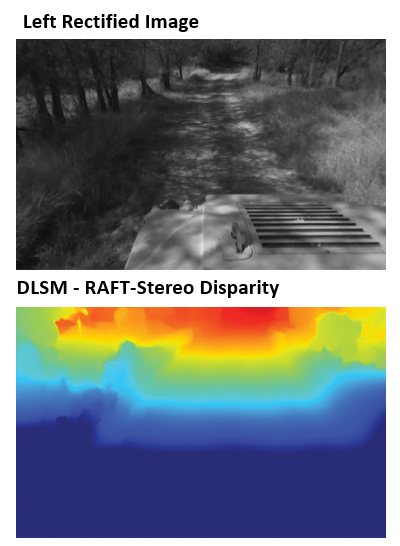
SwRI developed a stealthy vision-based system to perceive objects, model environments and simultaneously localize and map while navigating off-road environments.
“We reflected on the toughest machine vision challenges and then focused on achieving dense, robust modeling for off-road navigation,” said Abe Garza, a research engineer in SwRI’s Intelligent Systems Division.
Through internal research, SwRI engineers developed a suite of tools known as Vision for Off-Road Autonomy (VORA). The passive system can perceive objects, model environments and simultaneously localize and map while navigating off-road environments.
The VORA team envisioned a camera system as a passive sensing alternative to lidar, a light detection and ranging sensor, that emits active lasers to probe objects and calculate depth and distance. Though highly reliable, lidar sensors produce light that can be detected by hostile forces. Radar, which emits radio waves, is also detectable. GPS navigation can be jammed, and signals are often blocked in canyons and mountains.
“For our defense clients, we wanted to develop better passive sensing capabilities but discovered that these new computer vision tools could benefit agriculture and space research,” said Assistant Program Manager Meera Towler, who led the project.
In space, autonomous robots are limited by power, payload capacity and intermittent connectivity. Cameras make more sense than power-hungry lidar systems to explore planetary surfaces.
To overcome various challenges, the team developed new software to use stereo camera data for high-precision tasks traditionally accomplished using lidar. These tasks include localization, perception, mapping and world modeling.
“We apply our autonomy research to military and commercial vehicles, agriculture applications and so much more,” Towler said.
To see a video about VORA™ Autonomous Off-road Vehicle Technology, visit: https://www.youtube.com/watch?v=WeooiDpR-bs
SwRI Studies Earth's Magnetotail
SwRI is investigating an unusual event in the Earth’s magnetotail, the elongated portion of the planet’s magnetosphere trailing away from the Sun. Using data from the SwRI-led Magnetospheric Multiscale (MMS) mission, SwRI scientists are examining the nature of substorms, fleeting disturbances in the magnetotail that release energy and often cause aurorae.
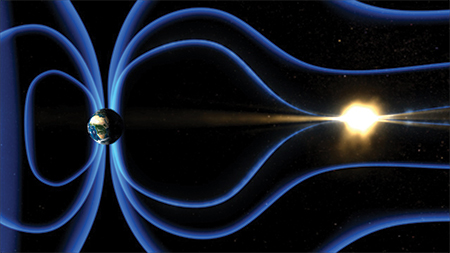
This illustration shows magnetic field lines around the Earth reconnecting in the magnetotail, usually one of the first signs of a substorm.
Since their launch in 2015, NASA’s four MMS spacecraft have been surveying the magnetopause, the boundary between the magnetosphere and surrounding plasma, for signs of magnetic reconnection. These phenomena occur when magnetic field lines converge, break apart and reconnect, explosively converting magnetic energy into thermal and kinetic energy. In 2017, MMS observed signs of magnetic reconnection in the magnetotail but not the normal signs of a substorm that accompany reconnection, such as strong electrical currents and perturbations in the magnetic field.
“We want to see how the local physics observed by MMS affects the entire global magnetosphere,” said SwRI’s Dr. Andy Marshall, a postdoctoral researcher. “By comparing that event to more typical substorms, we are striving to improve our understanding of what causes a substorm and the relationship between substorms and reconnection.”
During the one-year project, SwRI will compare in situ MMS measurements of reconnection affecting local fields and particles to global magnetosphere reconstructions hosted by the Community Coordinated Modeling Center at NASA’s Goddard Space Flight Center using the University of Michigan’s Space Weather Modeling Framework.
“It’s possible that significant differences exist between the global magnetotail convection patterns for substorms and non-substorm tail reconnection,” Marshall said. “We have not looked at the movement of the magnetic field lines on a global scale, so it could be that this unusual substorm was a very localized occurrence that MMS happened to observe. If not, it could reshape our understanding of the relationship between tail-side reconnection and substorms.”
Boiling Liquids in Low Gravity
To study how liquids boil in partial gravity, SwRI conducted experiments aboard two parabolic flights in April. The internally funded project, conducted in collaboration with Texas A&M University, is exploring how different surfaces affect the boiling process in low gravity.
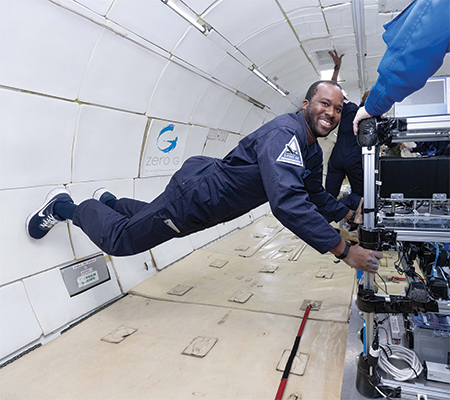
Courtesy of ZERO-G
Aboard a parabolic flight, SwRI Research Engineer Dr. Eugene Hoffman floats in partial gravity while conducting a fluids engineering experiment to better understand how liquids boil in low gravity.
Future extended space missions to the Moon or Mars will likely need to boil liquids for power generation, life support, cryogenic fuel production and in situ resource utilization, which uses local materials to support human exploration. On Earth, gravity helps separate liquids and gases through buoyancy. On the lunar or Martian surface, the lower buoyancy will affect boiling behavior, but simulating these conditions on Earth is challenging. Parabolic flights offer researchers brief periods of partial gravity to gain more insight into efficient and safe heat transfer processes at low gravity.
“We have so little data about how boiling works in reduced gravity,” said SwRI’s Kevin Supak, who leads the project. “Our experiment studies boiling in conditions that simulate lunar and Martian gravity levels using four different surfaces to examine how bubbles initiate and detach.”
The experiments will demonstrate whether engineered surfaces could improve boiling and bubble detachment in reduced gravity. At the microscopic level, rougher surfaces tend to form smaller bubbles and initiate boiling faster than smoother ones. SwRI’s Materials Engineering Department modified surface characteristics to study their effect on bubble sizes and distribution at different temperatures. The payload includes one plastic and three stainless-steel surfaces submerged in a specialized fluid that boils at the relatively low temperature of 135 degrees Fahrenheit.
SWORD: Robotics Programming, Simplified
SwRI is simplifying robotics programming with a new toolkit that integrates robotics motion planning, modeling and execution tools into a computer-aided design (CAD) application. The SwRI Workbench for Offline Robotics Development™ (SWORD™) features a user-friendly graphical interface to demystify the fundamental coding required in robot operating system (ROS) application development.

Informed by feedback from the ROS-Industrial community, engineers developed SWORD so manufacturing engineers can leverage advanced ROS capabilities in a familiar CAD environment. SwRI manages the ROS-Industrial Americas consortium and supports ROS-I software repositories, executing training and developer events.
“The traditional ROS workflow is programming-intense, requiring developers to be deeply familiar with available ROS libraries and tools. Even experienced ROS developers can spend significant time on initial setup and configuration,” said Matt Robinson, an SwRI engineer who manages the ROS-Industrial Americas consortium. “We listened to ROS experts and consortium members to develop SWORD and provide easier access to the ROS motion-planning tools, while sticking to a CAD-based environment familiar to non-developers.”
SWORD features a graphical toolkit for setting up motion planning environments and collision geometries. It can also test advanced robotic motion-planning applications and provides a graphical interface to many powerful motion-planning libraries. The goal is to adapt ROS to be more approachable for manufacturing and industrial audiences in a familiar environment.
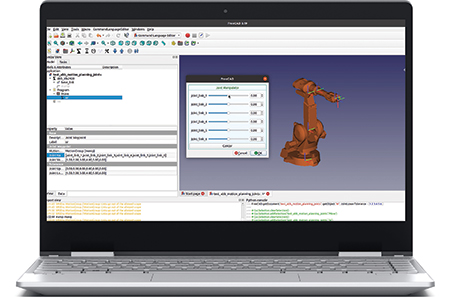
“SWORD is designed for both robotics developers and manufacturing engineers familiar with CAD processes and programs on process-oriented systems,” said SwRI’s Jeremy Zoss, who helped to develop the software.
SWORD contains environmental modeling tools that allow a user to fully describe the robot, fixtures, and end-of-arm tooling, using either imported geometry or locally created CAD features. SWORD generates motion plans using a selection of advanced planning libraries, creating custom pipelines for application-specific behavior while predicting and avoiding collisions.
Preparing for Europa Mission
SwRI is leading two teams to understand critical topics in advance of NASA’s Europa Clipper mission to the Jupiter moon. Both Precursor Science Investigations for Europa (PSIE) projects are investigating the connection between Europa’s icy surface and its subsurface, which is thought to contain a potentially habitable ocean.
Scheduled to launch in October 2024 and arrive in the Jupiter system in 2030, NASA’s Europa Clipper mission will place a spacecraft in orbit around Jupiter to perform a detailed investigation of Europa, one of the largest of Jupiter’s 90 moons. This precursor work will provide critical context to enable more efficient scientific analysis of Europa Clipper data, driving new discoveries. The projects may influence mission planning for the latter half of the prime mission and for any potential extended mission.
“Europa is considered one of the most likely sites in our solar system to potentially find life,” said SwRI’s Dr. Kelly Miller, who is leading one of the teams. “The most habitable environments at Europa are underneath the surface where there is liquid water. We need to measure and understand the relationship between the properties we measure and observe at the surface, and the properties in those interior environments.”
The availability of chemical energy sources depends on the history of the interior ocean and the abundance of organic and inorganic compounds it contains. The team will look at the evolution of chemical signatures from Europa’s interior to understand how we can distinguish between different possible interior environments without measuring those environments directly.
“We will combine models, observations, experiments and data science methods with the ultimate goal of improving the interpretation of Europa Clipper datasets,” Miller said. “The last steps of the research will use machine learning to process laboratory data collected from related chemical mixtures by the MAss Spectrometer for Planetary EXploration, or MASPEX, engineering model located at SwRI.”
The second SwRI-led team will specifically track ice shell evolution and material exchange between the surface and subsurface to predict the features likely to provide the best information and context for interpreting Europa Clipper data.
“Ahead of Europa Clipper, what we really need to know is how much the surface can tell us about Europa’s interior and ocean, and that’s the primary motivation of our project,” said Dr. Alyssa Rhoden, a principal scientist with SwRI and leader of the second team. “The breadth of this project lets us go after complex problems in our understanding of Europa — where surface geology, interiors and orbital dynamics are tightly coupled.”
The team will also incorporate recent laboratory experiments and Earth-based radar observations to reinterpret data collected by NASA’s Galileo mission to Jupiter (in orbit 1995–2003). Improving the understanding of Europa’s ice shell and its spectral properties will allow more rapid and accurate interpretation of Europa Clipper spectrometer data, characterizing Europa’s surface composition in detail, and provide a basis for identifying changes in Europa’s surface since Galileo.
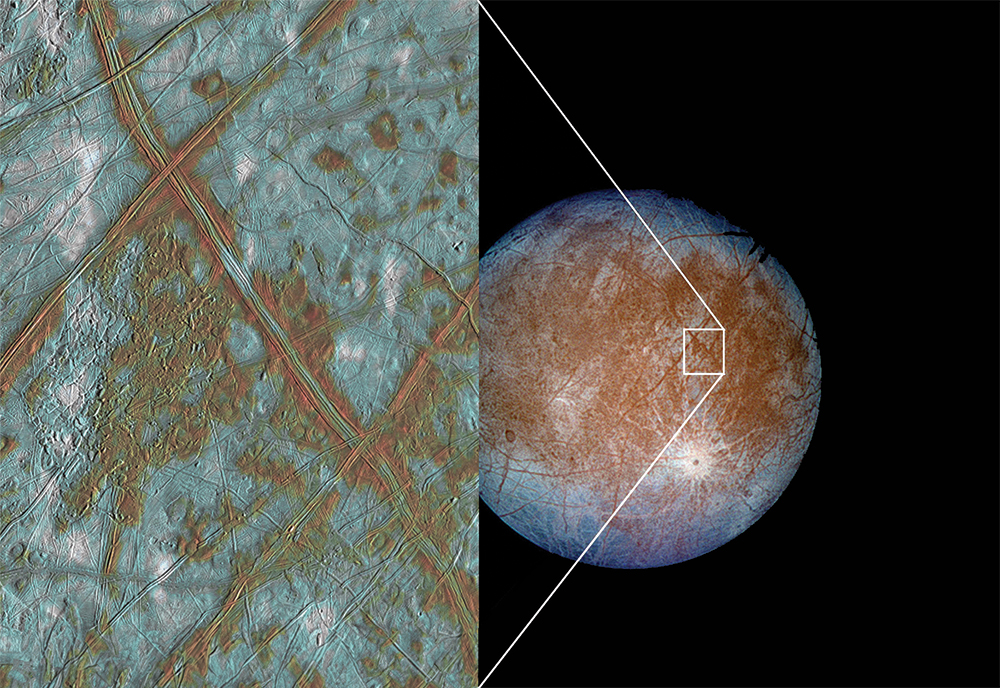
Courtesy of NASA/JPL/University of Arizona
SwRI is leading two Precursor Science Investigations for Europa teams to understand critical topics in advance of NASA’s Europa Clipper mission to the Jupiter moon. Both projects are investigating the connection between Europa’s icy surface and its subsurface, which is thought to contain a potentially habitable ocean.
RAD Measures Record Radiation on Mars
As principal investigator of the Radiation Assessment Detector (RAD) aboard NASA’s Curiosity rover, SwRI’s Dr. Don Hassler has been anticipating how epic events associated with solar maximum might play out on the surface of Mars.
Solar maximum, the regular period of high activity during the Sun’s 11-year solar cycle, is associated with large numbers of sunspots and solar storms. The resulting solar flares and coronal mass ejections produce solar energetic particles, high-energy protons that can penetrate planetary atmospheres. RAD is a coffee-can-sized instrument designed to ascertain the radiation exposure astronauts could encounter en route to and on the surface of Mars.
“RAD primarily measures two types of radiation on the surface of Mars, solar energetic particles produced by solar storms and galactic cosmic rays (GCRs), a continuous influx of high-energy particles that originate outside of the solar system, likely from explosive events like supernovae,” Hassler said.
The most significant event in the 12 years RAD has been roving the Red Planet occurred on May 20 when a solar flare expelled X-rays and gamma rays toward Mars, while a subsequent coronal mass ejection launched high-energy charged particles. Moving at the speed of light, the X-rays and gamma rays from the flare arrived first, while the charged particles trailed slightly behind, reaching the planet in just tens of minutes.
“If astronauts had been standing next to NASA’s Curiosity Mars rover at the time, they would have received a radiation dose of 8,100 micrograys — equivalent to 30 chest X-rays,” Hassler said. “While not deadly, it was the biggest surge measured by RAD so far, producing a spike of radiation eight times higher than normal.”
During solar events, the Sun releases a wide range of energetic particles. Only the most energetic can reach the surface to be measured by RAD. RAD’s data will help scientists plan for the highest level of radiation exposure that might be encountered by astronauts, who could use the Martian landscape for protection.
“Cliffsides or lava tubes would provide additional shielding for an astronaut from such an event. In Mars orbit or deep space, the dose rate would be significantly more,” said Hassler.
During the May 20 event, energy from the storm caused black-and-white images from Curiosity’s navigation cameras to dance with “snow” — white streaks and specks caused by charged particles hitting the cameras. Similarly, the star camera on NASA’s 2001 Mars Odyssey orbiter was inundated with energy from solar particles, momentarily going out. NASA’s MAVEN (Mars Atmosphere and Volatile EvolutioN) orbiter captured global glowing auroras over the planet.
“This active region on the Sun continued to erupt,” Hassler said. “We saw more solar storms at both Earth and Mars in the following weeks, as the Sun rotated back around. These storms weren’t quite as large as in May, but the solar maximum ’season’ is just beginning. It will be exciting to see what lies ahead.”
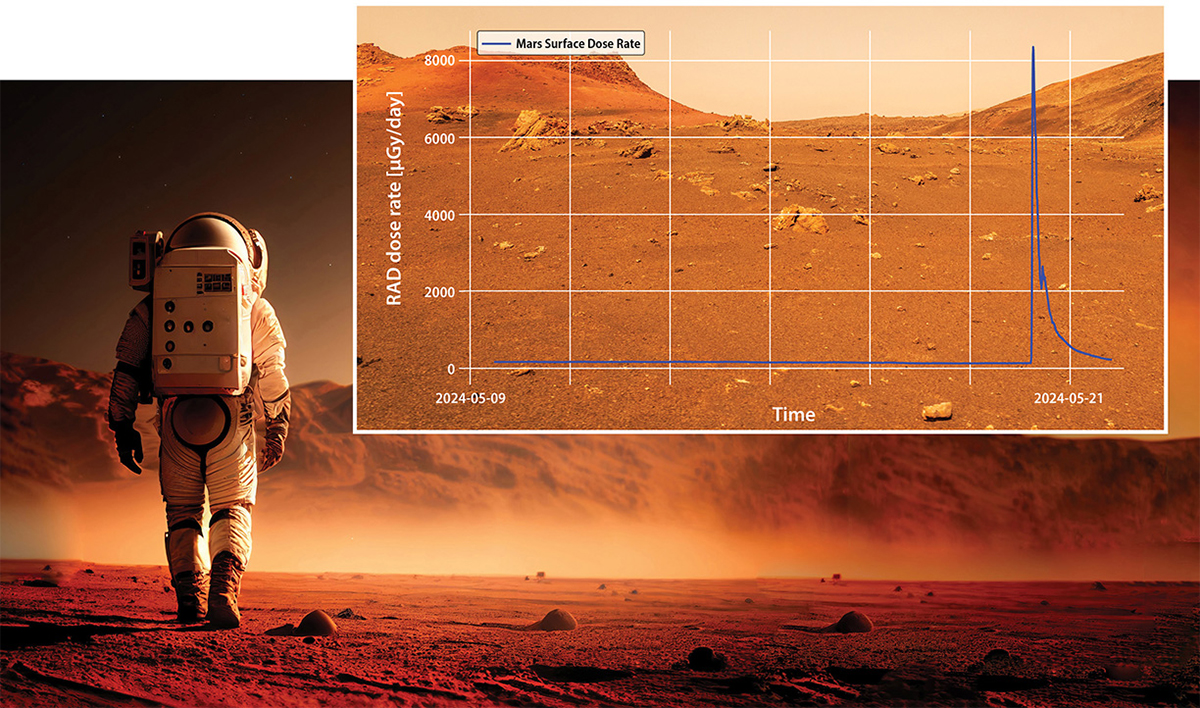
During a May 20 solar storm, the Radiation Assessment Detector, or RAD, saw a spike eight times higher than normal in the radiation dose measured on the surface of Mars. This is the highest dosage RAD has measured in the 12 years it has been roving the Red Planet aboard Curiosity.
Proving Pressure Relief Valve Performance
SwRI helped determine the viability of pressure relief valves for liquid natural gas tanks under train derailment conditions for the Federal Rail Administration (FRA). The SwRI research demonstrated that the pressure relief valves work as designed to prevent overpressurization and explosion in derailment scenarios.
“The pressure relief valves on tanks that transport liquid natural gas via rail are designed to vent the headspace of the liquid natural gas in the event of a derailment or a fire,” said SwRI’s Matt Gacek, who led the testing.
According to the Bureau of Transportation Statistics, trains derail on average more than 1,000 times each year, though they rarely result in fatalities or considerable damage.
“SwRI sought to determine if valves would still properly vent fluid after a railcar derails and flips over, causing the tank’s cryogenic liquid to flow through the valves,” Gacek said.
For safety reasons, SwRI used liquid nitrogen as a substitute for liquid natural gas and simulated the conditions the safety pressure valve would undergo in a train derailment.
SwRI determined the flow rates under various conditions and installed sensors measuring pressure, temperature and flow rate to the liquid nitrogen tank’s discharge line.
Then the project evaluated the impact of a potential fire from an operating pressure relief device. To accomplish this, SwRI created a pressurized natural gas flame and measured temperatures and heat fluxes at several safe distances.
“We discharged the natural gas at a variety of flow rates, ignited it and characterized the environment around the flame,” said Principal Engineer Jason Huczek of SwRI’s Fire Technology Department.
The fire testing data will validate computer modeling calculations, allowing future researchers to investigate a variety of accident scenarios. The project was conducted by the FRA-sponsored team, led by prime contractor Friedman Research Corporation, over 13 months between 2022 and 2023.
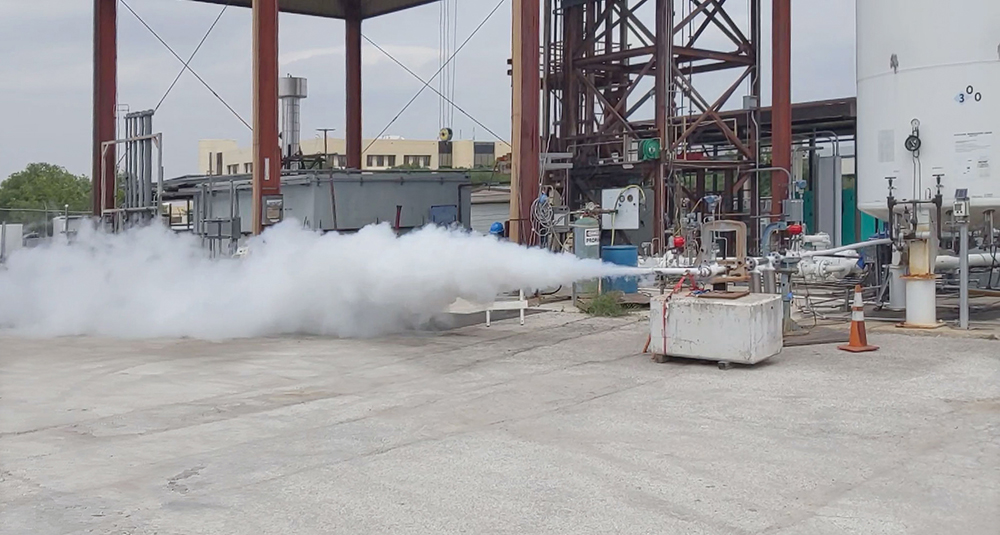
Developing Tomorrow's Aircraft Protection Technology
The U.S. Air Force is tapping into SwRI’s advanced electronic warfare expertise with a $6.4 million contract to explore cognitive electronic warfare (EW) techniques to accurately detect and respond to unknown enemy radar threats in real time. SwRI engineers are conducting research to develop a reliable algorithm that will advance the Air Force’s cognitive EW capabilities to better protect aircrews.

Courtesy of U.S. Air Force/Jake Melampy
Cognitive EW systems will accurately detect and respond to unknown enemy radar threats in real time, to disrupt or deceive enemy air attacks such as surface-to-air missiles or anti-aircraft artillery, as illustrated by the U.S. Air Force F-16 EW training exercise pictured.
“How do we get to the point where an EW system thinks like a human?” said SwRI Staff Engineer David Brown, who is leading the project. “A pilot can fly into an area and not know what’s there, but by analyzing the environment and signals, the pilot can choose a proper response to a threat. We are developing an algorithm that can analyze its environment the same way. It will sift through information with the reliability of a human but with higher accuracy and faster reaction times.”
Traditional EW processes use intelligence gathered before aircraft fly into an area to provide advance knowledge of the adversaries they might encounter and preload that information into aircraft electronic warfare systems. These systems alert pilots to detected threats and automatically respond to protect the aircraft.
In the past, the Air Force has relied on matching detected signals to a library of recognizable or comparable signals. A cognitive EW and machine learning approach can instantly identify new signals and respond with appropriate countermeasures.
SwRI’s cognitive EW work began as a multiyear, multimillion-dollar internal research and development (IR&D) project. Through its IR&D program, the Institute invests in tomorrow’s concepts to advance technology for government and industry clients.
SwRI Building Spacecraft for In-Space Refueling
SwRI will build, integrate and test a small demonstration spacecraft as part of a $25.5 million Space Mobility and Logistics (SML) prototyping project funded by the U.S. Space Force and led by prime contractor Astroscale U.S. The spacecraft, called the Astroscale Prototype Servicer for Refueling (APS-R), will refuel other compatible space vehicles while in geostationary orbit.
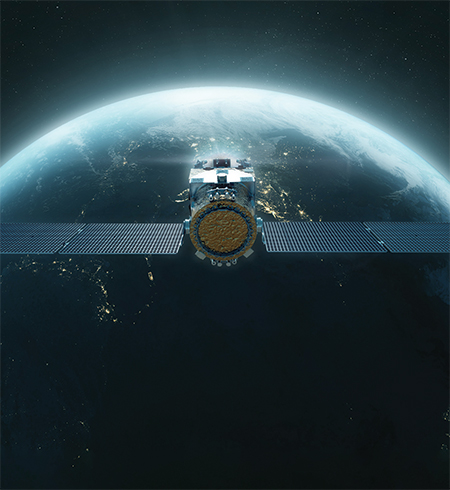
“Running low on fuel is a common issue for spacecraft in Earth orbit,” said SwRI ‘s Michael Epperly, the SwRI project manager. “When they have expended all of their fuel, their mission ends — even though the vehicle may be in otherwise excellent health. A refueling vehicle can extend those missions, getting additional lifetime out of spacecraft already in orbit.”
The APS-R will operate in geostationary orbit around the Earth. The spacecraft will carry hydrazine propellant from a depot, also in geostationary orbit, to spacecraft in need of fuel. The APS-R can service any spacecraft fitted with a compatible refueling port.
“Recently, other approaches to life extension have emerged, such as a vehicle that can use its thrusters to push another spacecraft where it needs to go after it runs out of fuel,” said Randy Rose, SwRI’s chief engineer of spacecraft development. “A refueling vehicle broadens life extension options with a flexible alternative.”
SwRI will construct the host vehicle for the APS-R in the Institute’s new 74,000-square-foot Space System Spacecraft and Payload Processing Facility, which provides rapid response to customers needing to design, assemble and test spacecraft, particularly small satellites.
SwRI will deliver the launch-ready APS-R by 2026.
SPARCI Characterizes Lunar Regolith
SwRI has received a three-year, $2,041,000 grant from NASA’s Development and Advancement of Lunar Instrumentation (DALI) program to further develop a novel ground-penetrating radar instrument. The Synthetic Pulse Artemis Radar for Crustal Imaging (SPARCI, pronounced “sparky”) instrument is designed to characterize the depth of the regolith and upper megaregolith, the upper broken-up layers of lunar crust associated with impact cratering.
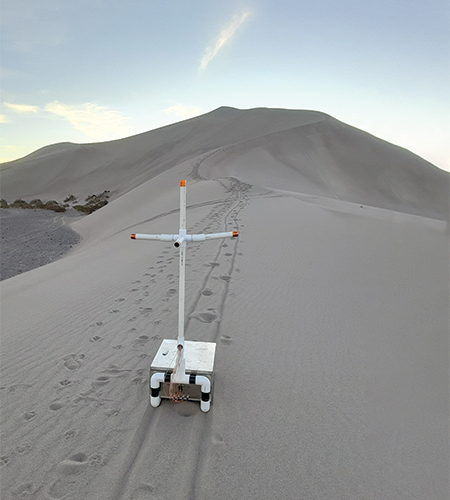
Courtesy of SwRI/Bryan Pyke and Astroscale U.S.
SwRI is one of five teams awarded funding by NASA’s DALI program, which supports the development of instruments for future lunar missions, including Commercial Lunar Payload Services and Artemis. DALI’s goal is to develop and demonstrate instruments that are technically ready to propose for upcoming flight opportunities. These instruments must significantly improve measurement capabilities for high-priority lunar science objectives.
When astronauts return to the Moon during the second half of this decade, their tasks will include deploying lunar instruments and using new technology to characterize the Moon. SPARCI’s two large transmitting antennas —172 and 40 meters in length — are designed for astronaut deployment. A robotic rover with much smaller antennas will then receive radar signals that penetrate the Moon’s subsurface. The ground-penetrating radar will measure the thickness and structure of the lunar megaregolith. Believed to be between 0.4 and 5 kilometers deep, the megaregolith formed just after the Moon solidified and likely experienced heavy bombardment from other objects during the early formation of the solar system.
“Learning more about the lunar megaregolith will help us gain a wider understanding of the Moon’s formation and that of similar bodies with thin, sparse atmospheres,” said SwRI’s Dr. David Stillman, the project’s principal investigator. “If we are able to pinpoint exactly where this layer begins, we can use that to create more accurate formation and evolution models.”
Oxygen Production on Jupiter's Moon Europa
NASA’s Juno spacecraft has directly measured charged oxygen and hydrogen molecules from the atmosphere of one of Jupiter’s largest moons, Europa. According to a new study co-authored by SwRI scientists and led by Princeton University, these observations provide key constraints on the potential oxygenation of its subsurface ocean.
“These findings have direct implications on the potential habitability of Europa,” said Juno Principal Investigator Dr. Scott Bolton of SwRI, a co-author of the study. “This study provides the first direct in situ measurement of water components existing in Europa’s atmosphere, giving us a narrow range that could support habitability.”
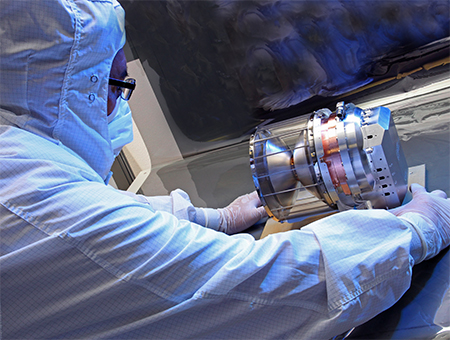
The SwRI-developed JADE instrument, shown prior to integration into the Juno spacecraft, detected significant amounts of charged molecular oxygen and hydrogen from Europa’s atmosphere. These data are important to understanding the potential habitability of the subsurface ocean within the Jupiter moon.
In 2022, Juno completed a flyby of Europa, coming as close as 352 kilometers to the moon. The SwRI-developed Jovian Auroral Distributions Experiment (JADE) instrument aboard Juno detected significant amounts of charged molecular oxygen and hydrogen lost from the atmosphere.
“For the first time, we’ve been able to definitively detect hydrogen and oxygen with in-situ measurements and further confirm that Europa’s atmosphere is made primarily of hydrogen and oxygen molecules,” said SwRI’s Dr. Robert Ebert, a co-author. The source of these molecules is thought to be water ice on Europa’s surface.
“Europa’s ice shell absorbs radiation, protecting the ocean underneath. This absorption also produces oxygen within the ice, so in a way, the ice shell acts as Europa’s lung, providing a potential oxygen source for the ocean,” said Princeton University’s Dr. Jamey Szalay, the study’s lead author.
“We designed JADE to measure the charged particles that create Jupiter’s auroras,” said SwRI’s Dr. Frederic Allegrini, another co-author. “Flybys of Europa were not part of the primary Juno mission. JADE was designed to work in a high-radiation environment but not necessarily Europa’s environment, which is constantly bombarded with high levels of radiation. Nonetheless, the instrument performed beautifully.”
SwRI Constructing First Facility Outside of Texas
For the first time in its 76-year history, SwRI has purchased land and is constructing a facility outside of its San Antonio home base. To support defense and intelligence programs, the Institute began construction on an $18.5 million, 33,000-square-foot facility on more than 8 acres in Warner Robins, Georgia, about three miles from Robins Air Force Base.

Courtesy of Pieper O'Brien Herr Architects
The new single-story building will house more than 50 SwRI staff members and consultants and will include new laboratory areas for the development of advanced aerospace and defense technology.
“We currently manage some of our government projects off-site at Robins Air Force Base,” said Winfield Greene, director of SwRI’s Advanced Electronic Warfare Department. “The new facility will allow us to handle this type of work in our own space to expand our support of the United States Air Force.”
Most SwRI staff members in the Warner Robins office are developing electronic warfare technology, countermeasure systems to protect aircraft from enemy weapons fire. The staff currently operates in a 15,000-square-foot, leased building. SwRI opened a Warner Robins office more than three decades ago to expand business opportunities and better serve clients at Robins Air Force Base.
SwRI operates 10 U.S. locations outside of its San Antonio headquarters as well as an international office in the United Kingdom. The Institute has a wholly owned subsidiary, Signature Science LLC, in Austin, Texas. Traditionally, the Institute leases office and laboratory space away from its home base, but purchasing property and building was the best solution to meet client needs in Warner Robins. The facility is expected to be complete by mid-2025.
“While we expand our footprint, we’re doing something good in the Warner Robins community, hiring and growing the local economy as well as keeping our warfighters safer,” Greene said.

